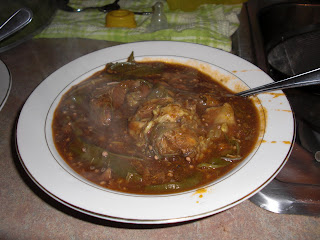 My mother used to make these for us, only she used the home-made, high cholesterol noodles, whereas I am using the lighter, No-Yolk noodles from the grocery store. Technically, you could use any noodle you like, but I like the wide No-Yolk noodles because they are similar in shape and size to the ones that my mother used.
My mother used to make these for us, only she used the home-made, high cholesterol noodles, whereas I am using the lighter, No-Yolk noodles from the grocery store. Technically, you could use any noodle you like, but I like the wide No-Yolk noodles because they are similar in shape and size to the ones that my mother used.
1 12 0z. package wide No-Yolk noodles
1 bunch parsley, stems removed, pulsed in the food processor, or roughly chopped with a knife
1 large pinch saffron fronds
2 to 3 cups water, for boiling the saffron
1 stick butter, browned in a small saucepan
salt
In a small pot, place about 2 to 3 cups of water, 2 tsp. salt, and the saffron and boil it until the water is a deep, rich orange color and some of the water has evaporated, you should have about a cup full left. Remove it from the heat and set it aside.
Boil the noodles according to package instructions, or until aldente texture is achieved, meaning still a little chewy, but almost done.
Pour the saffron water into the noodles and return the noodles to the lowest setting heat. Leave them covered until the saffron water has been absorbed.
Remove from heat, add the sizzling hot browned butter and the parsley and cover again, for about five minutes. Serve warm.
I loooooove these noodles. When I was pregnant I must have eaten a case of noodles this way. Now I have to eat my portion without the butter. *sigh* I spray mine with a little "I Can't Believe It's Not Butter" spray, and it tastes good, but not quite as wonderful as it does with the browned butter.
The left-overs are even better the following day, because the saffron flavor permeates the noodles more over night.


























